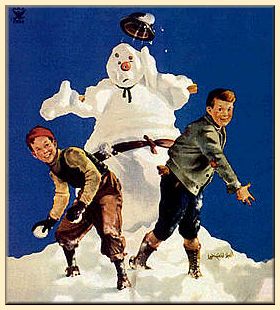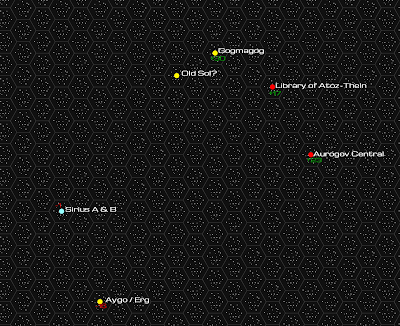Yesterday, the several members of my G+
Weird Adventures group reunited for a holiday-themed adventure. It was Yule-time in the City, and the "Team Victory" Detective Agency was holding an office party with Cornelius Doyle, Erskine Loone, and Boris Borofsky in attendance. Their secretary
Lola DeWytt was also there, and she'd brought a new friend the "lovely and mysterious"
Sara Snow.
The festivities were interrupted in short order by the kid gang known as the
Hardluck Hooligans. It seems the
Grumpf had not appeared to bedevil them, and the Hooligans suspected foul play. Why the concern? Well Da Brain (brainy kid with glasses) surmised that a Grumpf-less Yule would also mean a Father Yule-less season: something that just can't happen!
At Lola's urging, the gang takes the case with Sara tagging along. They start with investigating the place where Da Brain calculated the Grumpf should have appeared--and where the kids saw a out-of-place truck bearing the logo of Ardmann Commercial Displays. There is no sign of the Grumpf or the van, but they do find a amateurishly made flyer for Ardmann's.
Going the address listed, they find an old warehouse on Wharf Street along the Wyrd. The buildings got a freshly painted sign indicating it's Ardmann's. Sara and Loone go in to pose and potential customers, while Boris circles around back and Cornelius climbs a drain-pipe to the roof.
The interior has the necessary accoutrements of a commercial display business in the season: plyboard standups of reindeer, sleighs, and father Yule, and also some ceramic statues of what they take to be Father Yule's elf assistants. The two guys working there seem more like goons than salesmen, though, and Loone's power reveals they really just want the two customers to go as soon as possible.
There are other suspicious things. Boris finds the truck--and chains welded to the floor in the back of it. Cornelius peers through the skylight and sees something unusual (hidden from the view of Sara and Loone by stacks of crates): a big hole in the floor.
After comparing notes, the group enters the front door again, after Cornelius sees the two guys climb down a ladder into the hole. The investigation soon turns into a brawl, as the "elves" come to life and attack. The stone creatures are slow moving, but tough to harm, and our heroes are soon fighting a battle on two fronts as the goons start to climb back out of the hole.
Cornelius and Loone manage to force them back down while Boris methodically shotgun blasts the
gnomes (as they now reveal themselves) to pieces. Unfortunately, Loone is pushed into the hole by one of the gnomes before they're all done in.
In the cave beneath, Loone discovers the missing (and irate) Grumpf, inside some sort of glass dome that looks like a giant snowglobe with metal antennae pointed at it. And seated on a throne, there's also the apparent mastermind of this plot: the maniacal Gnome King!
An attempt to move the antenna gives Loone a powerful arcane jolt of holiday spirit energy, so the team concentrates on trying to break the glass dome. Weaving through would be assailants in cat form, Sara is able to cut off a switch, which seems to make the energy inside the globe to begin to build up.
As he and his minions attack, the Gnome King explains his plan in true villain fashion: He planned to capture the Grumpf and Father Yule (two sides of the same coin, really) and siphon their holiday energy to imbue himself with. With the cosmic reset coming at the end of the year, the power would be granted to him forever.
He hadn't reckoned on Team Victory and Sara Snow. The rock-hewn Gnome King is too tough for bullets (as Cornelius finds out), but thrown rocks and a couple of gunshots, combined with the energy overload since the siphon was turned off, leads to the Grumpf breaking free, stomping the Gnome King into the dirt, then giving Cornelius a sloppy kiss before bounding out into the night.
The Gnome King's crying and Yule is saved, thanks to our heroes...and the Hardluck Hooligans are the first on the Grumpf's list for whupping!




















